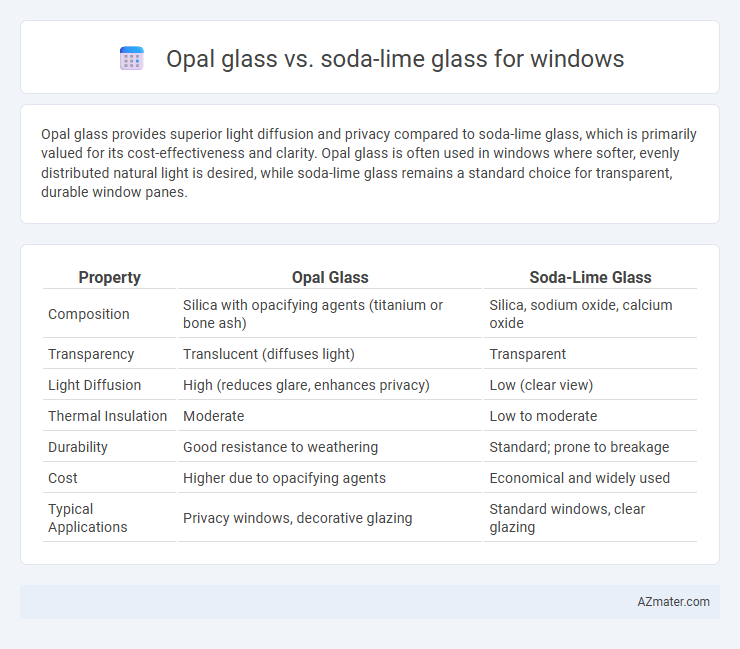Opal glass provides superior light diffusion and privacy compared to soda-lime glass, which is primarily valued for its cost-effectiveness and clarity. Opal glass is often used in windows where softer, evenly distributed natural light is desired, while soda-lime glass remains a standard choice for transparent, durable window panes.
Table of Comparison
| Property | Opal Glass | Soda-Lime Glass |
|---|---|---|
| Composition | Silica with opacifying agents (titanium or bone ash) | Silica, sodium oxide, calcium oxide |
| Transparency | Translucent (diffuses light) | Transparent |
| Light Diffusion | High (reduces glare, enhances privacy) | Low (clear view) |
| Thermal Insulation | Moderate | Low to moderate |
| Durability | Good resistance to weathering | Standard; prone to breakage |
| Cost | Higher due to opacifying agents | Economical and widely used |
| Typical Applications | Privacy windows, decorative glazing | Standard windows, clear glazing |
Understanding Opal Glass and Soda-Lime Glass
Opal glass is a type of frosted or milky glass known for its excellent light diffusion and privacy features, making it ideal for windows that require soft, even lighting without direct visibility. Soda-lime glass, the most common glass type for windows, offers high clarity, strength, and cost-effectiveness but lacks the translucency that opal glass provides. Understanding the differences between these materials helps determine the best choice for applications requiring either clear transparency or diffused illumination.
Key Composition Differences
Opal glass contains a higher concentration of titanium dioxide and tin oxide, which impart its characteristic milky opacity and diffuse light transmission, while soda-lime glass primarily consists of silica, sodium oxide, and calcium oxide, offering clear transparency and structural strength. The increased titanium dioxide in opal glass enhances UV resistance and reduces glare, making it ideal for diffused natural lighting applications in windows. Soda-lime glass's simpler composition results in lower production costs and greater mechanical durability, commonly used in standard windowpanes requiring clarity and impact resistance.
Optical Properties Comparison
Opal glass offers superior light diffusion and reduces glare significantly compared to soda-lime glass, making it ideal for applications requiring privacy and softened natural light. Soda-lime glass provides higher transparency and clarity, allowing maximum light transmission but with less control over light scattering. The optical properties of opal glass result from its microstructure, which scatters light to create a frosted effect, while soda-lime glass maintains a uniform, clear surface for unobstructed views.
Strength and Durability Analysis
Opal glass exhibits higher strength and scratch resistance compared to soda-lime glass, making it suitable for windows requiring enhanced durability. Soda-lime glass, while more affordable and commonly used, tends to be more brittle and susceptible to impact damage over time. The increased chemical stability of opal glass also contributes to its superior resistance against weathering and environmental stressors in window applications.
Thermal Performance in Windows
Opal glass provides superior thermal insulation compared to soda-lime glass due to its diffuse light transmission and reduced heat conductivity, enhancing energy efficiency in windows. Soda-lime glass, while more affordable and widely used, has higher thermal conductivity, resulting in greater heat transfer and less effective insulation. Choosing opal glass for windows significantly reduces heat loss and gains, improving indoor comfort and lowering energy costs.
Energy Efficiency Considerations
Opal glass offers superior energy efficiency compared to soda-lime glass due to its diffusive nature, which helps reduce glare and evenly distribute natural light, minimizing the need for artificial lighting. Soda-lime glass, while more common and cost-effective, has lower insulating properties, leading to higher heat transfer and increased energy consumption for heating and cooling. Choosing opal glass can significantly improve thermal performance and reduce HVAC energy usage, enhancing overall building sustainability.
Aesthetic and Design Flexibility
Opal glass offers a smooth, translucent finish that diffuses light evenly, enhancing interior aesthetics with a soft, elegant glow, while soda-lime glass provides clear, high transparency suited for unobstructed views and modern minimalistic designs. The versatility of opal glass allows for creative design applications such as frosted patterns and color variations, offering greater flexibility in achieving privacy without sacrificing natural light. Soda-lime glass remains ideal for applications requiring maximum clarity and structural integrity, yet lacks the customizable aesthetic options inherent to opal glass.
Cost Comparison: Opal vs Soda-Lime Glass
Opal glass typically costs 20-40% more than soda-lime glass due to its specialized manufacturing process and light-diffusing properties. Soda-lime glass remains the most economical choice for window applications, offering adequate strength and clarity at a lower price point. Budget-conscious projects favor soda-lime glass, while opal glass suits designs requiring enhanced privacy and diffused lighting despite the higher cost.
Common Applications in Modern Architecture
Opal glass is widely used in modern architecture for diffused natural lighting in office partitions, skylights, and decorative facade panels, offering privacy without sacrificing light transmission. Soda-lime glass remains the dominant choice for window applications due to its cost-effectiveness, durability, and clarity, commonly found in residential and commercial building windows. Both materials integrate seamlessly with energy-efficient glazing technologies, with opal glass favored for aesthetic and ambient light control functions, while soda-lime glass suits structural and visibility requirements.
Choosing the Right Glass for Your Windows
Opal glass offers enhanced privacy and diffuses natural light effectively, making it ideal for windows in bathrooms or office spaces where concealment is valued. Soda-lime glass, known for its affordability and clarity, is suitable for standard residential or commercial windows where unobstructed outdoor views are desired. Selecting the right glass depends on balancing factors like privacy needs, light diffusion, durability, and budget constraints for optimal window performance.

Infographic: Opal glass vs Soda-lime glass for Window
 azmater.com
azmater.com